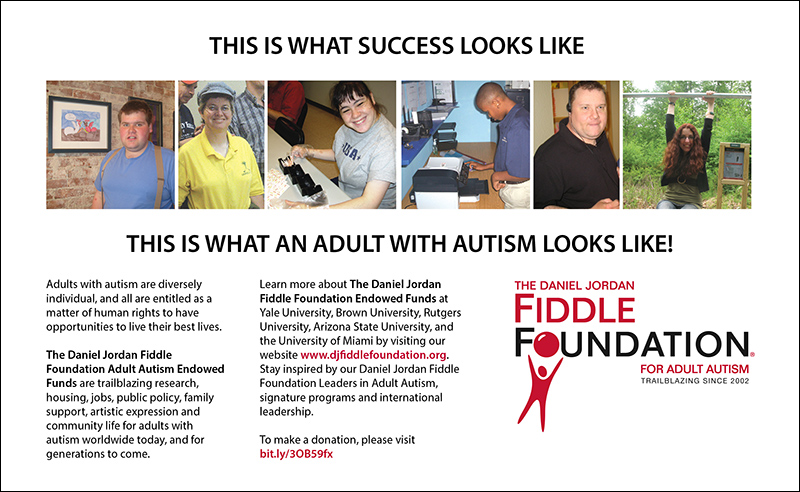In 2023, about 22.5% of people with a disability in the U.S. were employed, a shocking contrast to their age-matched, non-disabled peers that are employed at 65.8% (U.S. Bureau of Labor Statistics, 2023). Over the next decade, a significant number of youth with Autism Spectrum Disorder (ASD), ranging from 750,000 to 1 million individuals, will reach the age of eighteen, graduate high school, and be ready to join the workforce (Shattuck et al., 2012). Therefore, there is great need to provide appropriate interventions to improve employment outcomes for young adults with autism spectrum disorder (ASD).

The overall purpose of the Post-Professional OTD Capstone is to improve the prospects for employment for individuals with ASD to obtain suitable employment after high school by addressing interoperability issues between educational systems, vocational rehabilitation, and businesses that hire individuals on the spectrum.
This purpose will be achieved through teaching students self-determination skills utilizing a weekly curriculum, exposing students to vocational opportunities during their 9th-grade year through a bi-monthly “Get To Work” group, providing transition resources to caregivers and parents during their student’s annual IEP meeting, and writing a scoping review focused on self-determination interventions that improve employment for young adults with ASD.
Self-Determination
A total of 12 students from the 9th and 10th grades are participating in the self-determination group. The group is divided into two smaller groups that meet weekly during their lunch hour. The curriculum, adapted from the Self-Determined Learning Model of Instruction (SDLMI) developed by Dr. Karrie Shogren at the University of Kansas, has been customized to meet the specific needs of 9th and 10th-grade students with ASD. The following topics are covered in the group sessions:
- SMART Goals: Students learn the components of a SMART goal and how to write them.
- Goal Planning: Students learn the importance of setting goals, overcoming barriers, and tracking progress.
- Strengths, Weaknesses, and Preferences: Students identify their strengths, weaknesses, and preferences, particularly in relation to employment.
- Priorities: Students learn how to set priorities and make informed decisions.
- Time Management: Students develop skills to accurately estimate the time required for activities and prioritize tasks based on time constraints.
- Creating a Pros/Cons List: Students acquire organizational strategies for effective decision-making.
The outcomes of this group will emphasize the students’ abilities to write SMART goals for home, school, and future endeavors, track their progress, and enhance their understanding of self-determination. These findings will be published as part of the final Capstone Project in April 2025.
Get to Work Program
For this program, nine students meet twice monthly after school, participating in a total of twelve sessions and six job experiences. During the first week, students are taught essential soft skills, employability skills, and specific hard skills required for the workplace. The jobs included in the program are categorized by type (e.g., retail, hospitality, food service). In the second week, the group visits a local business, meets with the manager or owner, tours the facility, and learns the job components required for entry-level positions.
The following table represents the vocational opportunities provided for our students by job sector.

The results from the Vocfit assessment will be provided at the conclusion of this program to evaluate the student’s ability to independently perform the hard skills essential for employment.
Transition Resource Guide
A transition resource guide has been developed to support families and caregivers during their child’s 14-year-old Individualized Education Plan (IEP). At the beginning of the IEP meeting, time is allocated to distribute a physical copy of the transition resource list to caregivers and address any questions related to transition planning. After the meeting, caregivers receive a digital copy of the transition resource list, providing easier access to important information through digital links.
The resource guide includes the following documents:
- Vocational Rehabilitation Information: Guidance for parents to sign up for services through Opportunities for Ohioans with Disabilities (OOD)
- Transportation Assistance: Details on the Ohio State University’s Occupational Therapy Driver Rehabilitation Program
- Chore List: A list designed to help students improve hard skills related to employment
- Local School Trade programs: information on trade programs offered by local schools
Scoping Review
A scoping review is being conducted to analyze research that utilized self-determination as an intervention to improve employment outcomes for adults with Autism Spectrum Disorder (ASD) (18-24).
Eleven studies have been included in the scoping review with the following eligibility criteria:
- Diagnosis of autism, autism spectrum disorder
- Age 18-24
- Use of self-determination as an intervention
- Intervention related to employment outcomes
- Journal articles from 2009-2024
Self-determination interventions have varied in duration, scope, and approach. The results of the scoping review demonstrated that the degree of self-determination of youth with autism can serve as a predictor for transition outcomes. The complete findings of the scoping review will be published in April 2025 to identify evidenced-based self-determination interventions that improve employment for young adults with ASD.
This article has been approved by Michelle Woodbury, PhD, OTR/L, Program Director for the Post-Professional Occupational Therapy Doctorate at the Medical University of South Carolina. She can be reached at WoodbuML@musc.edu or by phone at 843-792-1671.
Matthew Husband, MS, OTR/L, is the inaugural Postal -doctoral Fellow of The Daniel Jordan Fiddle Foundation Adult Autism Endowment Fund Focused on Direct Care Services at the Medical University of South Carolina College of Health Professions. For more information, email husband@musc.edu or call (703) 618-7202.
References
Shattuck, P.T., S.C. Narendorf, B. Cooper, P.R. Sterzing, M. Wagner, and J.L. Taylor. (2012) Postsecondary Education and Employment among Youth with an Autism Spectrum Disorder. Pediatrics, Vol. 129, No. 6, 2012, pp. 1042–1049.
U.S. Bureau of Labor Statistics. (2023). Persons with a disability: Labor force characteristics summary. Retrieved from www.bls.gov/news.release/pdf/disabl.pdf







